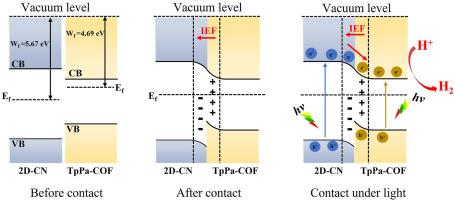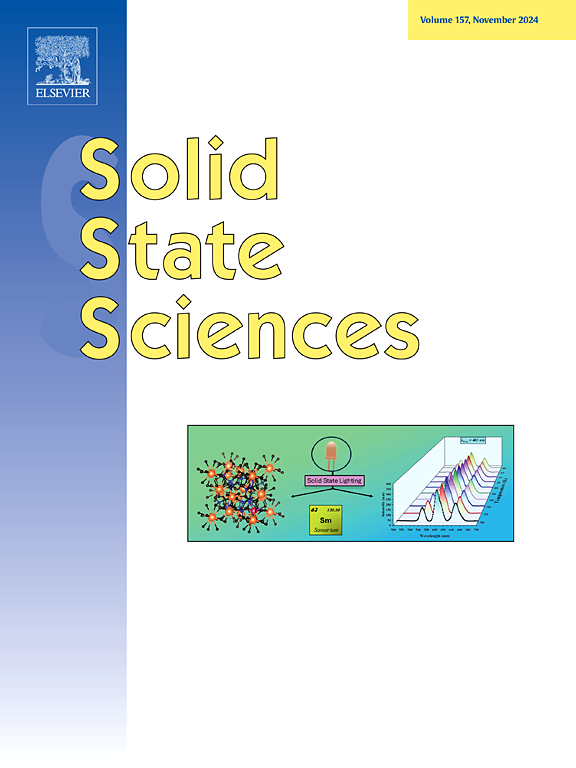二维石墨氮化碳/共价有机骨架异质结构增强光催化析氢
IF 3.3
3区 化学
Q2 CHEMISTRY, INORGANIC & NUCLEAR
引用次数: 0
摘要
成功制备了二维g-C3N4 (2D-CN)和共价有机骨架(TpPa- cof)组成的异质结,命名为2D-CN/TpPa。TEM和XPS表征证实2D-CN与2D-CN/TpPa中的TpPa- cof有良好的接触。2D- cn的碎片化二维纳米片结构有助于与TpPa-COF形成更有效的异质结。在可见光照射下,2D-CN/TpPa15的H2析出率最高,为19539 μmol g−1 h−1,高于BCN/TpPa15的13279 μmol g−1 h−1,分别比2D-CN和TpPa-COF提高3.8倍和148倍。DFT计算表明,2D-CN比TpPa- cof具有更高的Wf,从而在2D-CN/TpPa中形成了一个从TpPa- cof指向2D-CN的内嵌电场,这有利于光生电子在光激发下从2D-CN的CB向TpPa- cof的CB迁移。连续实验表明,2D-CN/TpPa15的光催化活性在24 h后保持稳定。本研究提出了一种开发具有显著增强光催化性能的g- c3n4基复合材料的有前途的策略。本文章由计算机程序翻译,如有差异,请以英文原文为准。

2D-graphite carbon nitride/covalent organic framework heterostructure for enhanced photocatalytic H2 evolution
Heterojunctions composed of two-dimensional g-C3N4 (2D-CN) and covalent organic framework (TpPa-COF) were successfully prepared and named as 2D-CN/TpPa. TEM and XPS characterizations confirm that there is good contact between 2D-CN and TpPa-COF in the 2D-CN/TpPa. The fragmented 2D nanosheet structure of 2D-CN facilitates the formation of a more efficient heterojunction with TpPa-COF. 2D-CN/TpPa15 achieved the highest H2 evolution rate of 19539 μmol g−1 h−1 under visible light irradiation, which is higher than that of BCN/TpPa15 (13,279 μmol g−1 h−1) and represented a 3.8-fold and 148-fold improvement over 2D-CN and TpPa-COF, respectively. DFT calculations indicate that 2D-CN possesses a higher Wf than TpPa-COF, thereby inducing the formation of a built-in electric field directed from TpPa-COF to 2D-CN in the 2D-CN/TpPa, which facilitates the migration of photogenerated electrons from the CB of 2D-CN to that of TpPa-COF under photoexcitation. Continuous experiments demonstrates that the photocatalytic activity of 2D-CN/TpPa15 remained stable following a 24 h photocatalytic reaction. This study proposes a promising strategy for developing g-C3N4-based composites with substantially enhanced photocatalytic performance.
求助全文
通过发布文献求助,成功后即可免费获取论文全文。
去求助
来源期刊

Solid State Sciences
化学-无机化学与核化学
CiteScore
6.60
自引率
2.90%
发文量
214
审稿时长
27 days
期刊介绍:
Solid State Sciences is the journal for researchers from the broad solid state chemistry and physics community. It publishes key articles on all aspects of solid state synthesis, structure-property relationships, theory and functionalities, in relation with experiments.
Key topics for stand-alone papers and special issues:
-Novel ways of synthesis, inorganic functional materials, including porous and glassy materials, hybrid organic-inorganic compounds and nanomaterials
-Physical properties, emphasizing but not limited to the electrical, magnetical and optical features
-Materials related to information technology and energy and environmental sciences.
The journal publishes feature articles from experts in the field upon invitation.
Solid State Sciences - your gateway to energy-related materials.
 求助内容:
求助内容: 应助结果提醒方式:
应助结果提醒方式:


